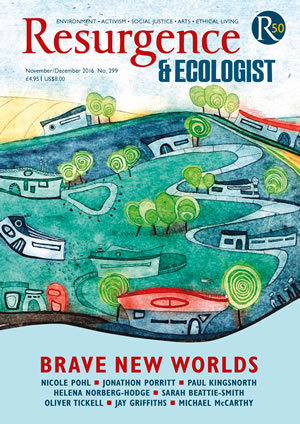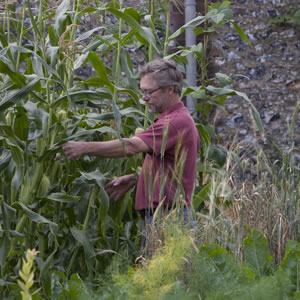“Just focusing on GMOs (genetically modified crops) is not enough. The point is, what is happening in the fields even without GMOs? Industrial agriculture only works with tons of soluble nitrogen, fungicide, insecticide and herbicide. And the result is that the bees are dying out. We cannot go on like this. GMOs are just the final tweak in the entire system of industrial agriculture that is destroying our environment and ruining our health. So we have to do more than just complain about it. We have to set out the alternative.”
I meet John Letts – academic, organic farmer, archaeobotanist, crop breeder and agricultural revolutionary – at the Buckinghamshire farm where he is now growing 50 acres of “heritage grains”, a term he invented some 15 years ago to describe the genetically diverse seed mixes he has spent much of his life developing. With harvest in full swing, time is tight, and John is spending 12-hour days on his 1970s vintage combine harvester.
But he takes time off to show me round the farm. The ingenious and effective 1890s winnowing machine that separates grain, chaff and weed seeds, given to him by an Oxfordshire farmer, lovingly restored. The walled garden with a thousand ancient varieties of wheat, rye, oats and barley, set out in small experimental stands of about a square foot each. And then the fields.
The first thing you notice about John’s wheat fields is the tangle of weeds that covers the ground to a height of two to three feet. Then, rising above, the extravagant height of the wheat, seed heads hanging four or five feet above the ground – allowing the grain to be (more or less) cleanly harvested, leaving weeds and high stubble to be ploughed back into the soil and raise its organic content.
Back in the barn, John reaches into a sack of wheat. “There’s a thousand times more genetic diversity in this one handful of grain than in an entire 100-acre field on a conventional farm,” he says. Composed of 150 varieties from seed banks and farmers across northern Europe, it’s nothing short of a genetic treasure, secured by being grown. “The only really safe place for seeds is growing in the field. I have had grain from seed banks that has never germinated. Seeds are only safe in the hands of farmers and when they are planted.”
But what exactly is so important about all this genetic diversity? First we have to understand the extraordinary “genetic cleansing” that has taken place since the early 20th century. For millennia, cereals were grown as ‘landraces’, incorporating three levels of diversity. Every field would include maybe half a dozen separate cereal species, divisible into as many as 200 varieties. Each would, in turn, embody considerable genetic diversity.
During the 19th century, farmers in search of higher yields began to pick out specific lines that yielded higher returns under ideal agronomic conditions. Then, in search of greater stability and uniformity, crop breeders selected single seeds from these lines, bulked them up over successive plantings, then named and marketed them as distinct varieties. The next step, which began shortly before the first world war, was to hybridise these named varieties in search of the ideal combination of agronomic qualities, putting together, for example, traits for large seed heads and short straw to increase yields yet further – again, under ideal conditions – and increase profitability for ‘efficient’ farmers.
“What the plant breeders have achieved is to wipe out 99.99% of the original genetic diversity in the field,” says John. “Production has shot up, but so have inputs. The crops respond well to nitrogen, but they are shallow-rooted and can’t reach down into the subsoil for water and nutrients. Because they are genetically uniform they can no longer evolve in the field to withstand insects and fungi and have to be constantly sprayed with pesticides. The short straw length means that more of the plants’ energy goes into the grain – but then they can’t grow up above the weeds, so the system relies on repeated use of herbicides.
“And a huge concern now is climate change. We need genetically diverse crops that can evolve to meet changing conditions, producing reliable yields all the time, rather than maximum yield when everything is just right but with the risk of total crop failure when you get flood, or drought, or some new insect or fungus or virus. We need crops that can adapt, and that means what we call ‘evolutionary plant breeding’ rather than the usual ‘selective plant breeding’. We have to breed the crops we rely on for a period of instability, and that means genetic diversity.”
A seminal moment in John’s life came when he was working at the Oxford University Museum of Natural History, analysing remains of vegetation found at archaeological sites anywhere from hundreds to many thousands of years old, identifying species and drawing conclusions about food, diet, farming systems and climate. One day a friend of a friend brought him a shoebox full of soot-blackened straw taken from a medieval house where the original thatch was being stripped down to the rafters and replaced.
“I was sitting at Thomas Henry Huxley’s old desk in the museum when the lid came off, and there were 20 kinds of wheat in this one box, and every ear was different. This was from the base layer of the thatch, which historically was never changed, until the new fashion for thatching with water reed instead of wheat straw. And this one box of thatch preserved in the smoke of a medieval hall was like a time capsule of information about 16th-century farming.
“At that time all this priceless archaeological material was being burned and dumped from old houses all over Britain. Now we have mostly put a stop to that: it is illegal to destroy this stuff. But it also led me to campaign to preserve our thatching tradition using wheat straw rather than the imported water reed. However, for thatching you obviously need long straw, and all the modern varieties are way too short. The straw also has to be grown organically or it contains too much nitrogen and rots too fast.
“So I began to search out and grow old varieties of wheat to provide good-quality straw for thatching. I collected wheat from all over the world, from farmers and gene banks, and put them together to breed a hardy, deep-rooted landrace that would grow well in a low-nutrient environment and on a range of soils and weather conditions. In fact, you have to grow it organically, because with fertiliser it grows 10 feet high! But soon we were producing all this grain as a by-product of the straw, so I began to experiment with it for baking flour and found it made really rich, tasty loaves. But at the time there was no market for it, so I began to create one.
“The good news is that there are now a lot of people out there who want this flour to bake with. Thank goodness for the artisanal baking tradition and shoppers who want something more than gluten-enriched fluffy white bread! There’s a massive niche market opening up for real flour for baking real bread or making real pasta. I have been screaming away about all the advantages of heritage grains. They are high in minerals because of their deep roots, and they have a different gluten profile that is less likely to cause gluten intolerance, especially if the baker uses a long fermentation.”
In John’s ideal world, farmers would be growing genetically diverse cereal landraces that have evolved in their local soils and microclimates, with the grains milled either on the farm or by local millers, in turn supplying local bakers making unique local breads.
This would involve deep changes in the current system of bread production, in which conventional farmers are receiving around £125 per tonne of wheat. With an 800g loaf needing 550g of flour, that implies that the actual wheat that makes a loaf that may sell for anything from 45p for a supermarket value loaf to £5 for an artisanal product is worth only about 10–15p. The sometimes very wide price disparity means that there is scope for farmers to receive a much higher price for a genuinely superior product like heritage wheat or rye.
These heritage grains could also provide a huge boost for organic farmers, most of whom currently grow conventional cereal varieties bred for intensive farming systems.
“Of course it doesn’t work, as they need a lot of soluble nitrate in the upper soil layers in order to produce – and that’s scarce in organic farming systems,” John says. “Most modern wheats have also lost the ability to connect with root fungi, mycorrhizae. And that’s a disaster because the mycorrhizae quadruple the effective root matter of the wheat plants and hence their ability to scavenge water and minerals. But now farmers can grow heritage grains that have been specially bred for organic conditions, and the organic movement is waking up to that.”
But there is another problem: the Plant Varieties and Seeds Act 1964, which requires that seeds offered for sale meet strict criteria, including that they are officially registered (a process that may cost the seed developer £100,000 or more), and that they are “distinct, uniform and stable”. Transgressors may be fined and jailed for up to three months. Clearly these heritage grains are not registered, nor is it even possible for them to be, since far from being “distinct, uniform and stable” they are “distinctively diverse and constantly evolving”, says John. “The exact opposite of what they should be!”
So instead of selling the seed, John rents it to growers under a “seed user agreement” while remaining its legal owner. “They can use the crop they grow for milling or malting, but they cannot transfer the seed. Defra (the Department for Environment, Food and Rural Affairs) did once say I had to stop what I was doing, but I said I was doing nothing illegal: it is being grown under contract and I am not transferring ownership. Then they tried to tell me that I could only grow my heritage grains on my own land. So I asked them where the law said that, and they backed off.”
Just possibly another factor could be that Prince Charles’s Highgrove Estate is currently growing a crop of John’s heritage rye. While Defra’s seed inspectors might be willing to take on Mr John Letts (though even that might generate an international storm of protest), picking a fight with HRH The Prince of Wales would be another thing altogether.








